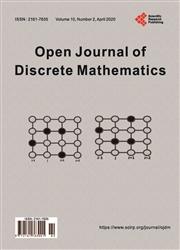On Tilings of Quadrants and Rectangles and Rectangular Pattern
引用次数: 4
Abstract
The problem of tiling rectangles by polyominoes generated large interest. A related one is the problem of tiling parallelograms by twisted polyominoes. Both problems are related with tilings of (skewed) quadrants by polyominoes. Indeed, if all tilings of a (skewed) quadrant by a tile set can be reduced to a tiling by congruent rectangles (parallelograms), this provides information about tilings of rectangles (parallelograms). We consider a class of tile sets in a square lattice appearing from arbitrary dissections of rectangles in two L-shaped polyominoes and from symmetries of these tiles about the first bisector. Only translations of the tiles are allowed in a tiling. If the sides of the dissected rectangle are coprime, we show the existence of tilings of all (skewed) quadrants that do not follow the rectangular (parallelogram) pattern. If one of the sides of the dissected rectangle is 2 and the other is odd, we also show tilings of rectangles by the tile set that do not follow the rectangular pattern. If one of the sides of the dissected rectangle is 2 and the other side is even, we show a new infinite family of tile sets that follows the rectangular pattern when tiling one of the quadrants. For this type of dis-section, we also show a new infinite family that does not follow the rectangular pattern when tiling rectangles. Finally, we investigate more general dissections of rectangles, with. Here we show infinite families of tile sets that follow the rectangular pattern for a quadrant and infinite families that do not follow the rectangular pattern for any quadrant. We also show, for infinite families of tile sets of this type, tilings of rectangles that do not follow the rectangular pattern.关于象限、矩形和矩形图案的平铺
用多项式平铺矩形的问题引起了很大的兴趣。一个相关的问题是用扭曲多项式平铺平行四边形的问题。这两个问题都与用多项式对(倾斜)象限进行平铺有关。实际上,如果一个(倾斜的)象限的所有平铺都可以被一个平铺集合简化为一个全等矩形(平行四边形)的平铺,这就提供了关于矩形(平行四边形)平铺的信息。我们考虑了正方形点阵中的一类瓦片集,这些瓦片集是由两个l形多边形中矩形的任意剖分和这些瓦片关于第一等分线的对称性产生的。在平铺中,只允许对平铺进行翻译。如果解剖矩形的边是互素数,我们证明了所有(倾斜的)象限的平铺的存在,这些象限不遵循矩形(平行四边形)模式。如果被分割的矩形的一条边是2,另一条边是奇数,我们也会显示不遵循矩形图案的矩形的瓷砖集的瓷砖。如果被分割的矩形的一条边是2,另一条边是偶数,我们展示了一个新的无限族的瓷砖集,遵循矩形模式,当平铺一个象限。对于这种类型的分解,我们还展示了一个新的无限族,它在平铺矩形时不遵循矩形模式。最后,我们研究更一般的解剖矩形,与。在这里,我们展示了在一个象限中遵循矩形模式的无限族瓦片集,以及在任何象限中不遵循矩形模式的无限族瓦片集。我们还证明,对于这种类型的无限族的瓦片集,不遵循矩形图案的矩形瓦片。
本文章由计算机程序翻译,如有差异,请以英文原文为准。
求助全文
约1分钟内获得全文
求助全文

 求助内容:
求助内容: 应助结果提醒方式:
应助结果提醒方式:


